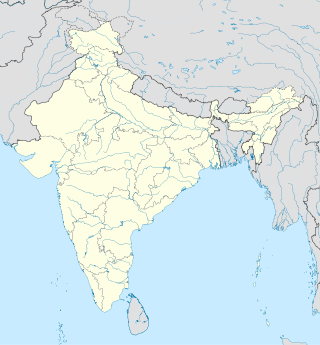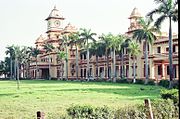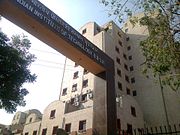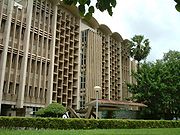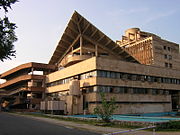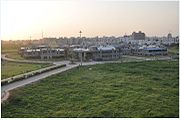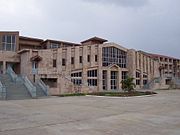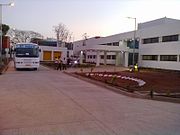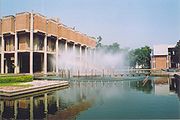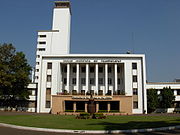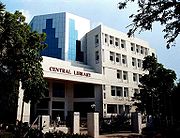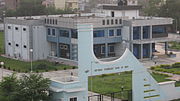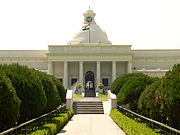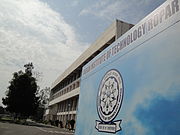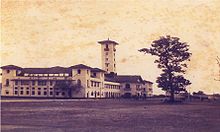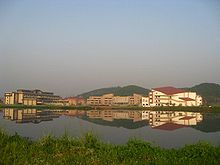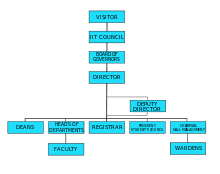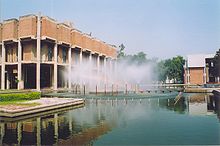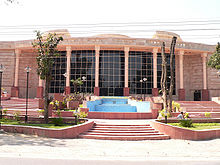
Indian Institutes of Technology
Background to the schools Wikipedia
SOS Children, an education charity, organised this selection. Click here for more information on SOS Children.
The Indian Institutes of Technology (IITs) are a group of autonomous public engineering institutes of India. The IITs are governed by the Institutes of Technology Act, 1961 which has declared them as "institutions of national importance", and lays down their powers, duties, framework for governance etc. The Institutes of Technology Act, 1961 lists sixteen institutes located at Bhubaneswar, Chennai, Delhi, Gandhinagar, Guwahati, Hyderabad, Indore, Jodhpur, Kanpur, Kharagpur, Mandi, Mumbai, Patna, Ropar, Roorkee and Varanasi. Each IIT is an autonomous institution, linked to the others through a common IIT Council, which oversees their administration. The IITs usually offer many degrees starting from B.Tech to Ph.D.
The IITs have a common admission process for undergraduate admissions. Though Indian Institute of Technology Joint Entrance Examination (IIT-JEE), which in 2011 had an acceptance rate of less than 1 in 50 (485,000 candidates and only 9,618 seats). Undergraduate students will eventually receive a B. Tech. degree in Engineering. The graduate level program that awards M. Tech. degree in engineering is administered by the older IITs (Kharagpur, Bombay, Madras, Kanpur, Delhi, Varanasi, Guwahati, Roorkee). M.Tech. admission decisions are made on the basis of Graduate Aptitude Test in Engineering (GATE). In addition to B. Tech and M. Tech programs IITs also award other graduate degrees such as M.Sc. in Engineering, Maths, Physics and Chemistry, MBA, PhD and more. Admission to these programs are through Common Admission Test (CAT), Joint Admission Test to M.Sc. (JAM) and Common Entrance Examination for Design (CEED).
IIT alumni have achieved success in a variety of professions. IITs are Institutes of National Importance established through special acts of Indian Parliament.
Institutes
The IITs are located in:
| Name | Photo | Short Name | Established | City/Town | State/UT |
|---|---|---|---|---|---|
| IIT (BHU) Varanasi |  |
IIT(BHU) | 2012‡(found in 1919) | Varanasi | Uttar Pradesh |
| IIT Bhubaneswar |  |
IITBBS | 2008 | Bhubaneswar | Orissa |
| IIT Bombay |  |
IITB | 1958 | Mumbai | Maharashtra |
| IIT Delhi |  |
IITD | 1963‡(found in 1961) | New Delhi | Delhi |
| IIT Gandhinagar |  |
IITGN | 2008 | Gandhinagar | Gujarat |
| IIT Guwahati |  |
IITG | 1994 | Guwahati | Assam |
| IIT Hyderabad |  |
IITH | 2008 | Hyderabad | Andhra Pradesh |
| IIT Indore |  |
IITI | 2009 | Indore | Madhya Pradesh |
| IIT Kanpur |  |
IITK | 1959 | Kanpur | Uttar Pradesh |
| IIT Kharagpur |  |
IITKGP | 1951 | Kharagpur | West Bengal |
| IIT Madras |  |
IITM | 1959 | Chennai | Tamil Nadu |
| IIT Mandi |  |
IIT Mandi | 2009 | Mandi | Himachal Pradesh |
| IIT Patna |  |
IITP | 2008 | Patna | Bihar |
| IIT Jodhpur |  |
IITJ | 2008 | Jodhpur | Rajasthan |
| IIT Roorkee |  |
IITR | 2001‡(found in 1847) | Roorkee | Uttarakhand |
| IIT Ropar |  |
IITRPR | 2008 | Rupnagar | Punjab |
‡ – year converted to IIT
Institutes of Technology Act, 1961
The first IIT was established in 1951, in Kharagpur (near Kolkata) in the state of West Bengal. It has 29 academic departments, centres and schools, spread over an 8.5 square kilometres (2,100 acres) campus that is a self-contained township of over 15,000 inhabitants. It has about 450 faculty; 2,200 employees; 3,000 undergraduates; 2,500 postgraduates and 950 research scholars. The students live in 17 hostels (called Halls of Residence). IIT Kharagpur also has a medical technology school ( School of Medical Science and Technology), a management school ( Vinod Gupta School of Management), a law school ( Rajiv Gandhi School of Intellectual Property Law) and an infrastructure designing school (Ranbir and Chitra Gupta School of Infrastructure Designing and Management) within its premises.
The second IIT to be established, IIT Bombay, was founded in 1958 in Powai, Mumbai, Maharashtra. It was set up with assistance from UNESCO and the Soviet Union, which provided technical expertise. The Indian government underwrote all other expenses, including the construction costs. With an area of 2.23 square kilometres (550 acres) and a total of 24 departments, centres and schools. In addition, IIT Bombay has 14 student hostels with about 2,200 undergraduate and 3,500 postgraduate students. IIT Bombay also has schools in management ( Shailesh J. Mehta School of Management) and information technology (Kanwal Rekhi School of Information Technology) on its premises. Despite a change in the name of the city, the IIT retains the original name.
IIT Madras is located in the city of Chennai in Tamil Nadu. It was established in 1959 with technical assistance from the Government of West Germany and has nearly 450 faculty members and approximately 2,500 undergraduate and 2,000 postgraduate students. The campus is spread over an area of about 2.5 square kilometres (620 acres), and has 16 academic departments, nearly 100 laboratories, and 17 hostels. As with IIT Bombay, it retains its original name despite a change in the name of its city.
IIT Kanpur was established in 1959 in the city of Kanpur, Uttar Pradesh. During its first 10 years, IIT Kanpur benefited from the Kanpur–Indo-American Programme, where a consortium of nine US universities helped to set up the research laboratories and academic programmes. It covers an area of 4.85 square kilometres (1,200 acres). It has approximately 500 faculty members, and about 2,000 undergraduate and an equal number of postgraduate students living in 10 hostels.
Established as the College of Engineering in 1961, IIT Delhi was given the current name and declared an Institution of National Importance under the "Institutes of Technology (Amendment) Act, 1963". It is located in Hauz Khas (New Delhi) and has an area of 1.3 square kilometres (320 acres). It has 11 hostels and 26 departments, centres and schools. It has 426 faculty members and approximately 2,200 undergraduate and 1,600 postgraduate students.
IIT Guwahati was established in 1994 near the city of Guwahati ( Assam) on the northern banks of the Brahmaputra River. The sprawling 2.85 square kilometres (700 acres) campus attracts many visitors because of its scenic beauty. As of 2012, there are approximately 2,000 undergraduate and 1,900 postgraduate students in eleven departments and three academic centres and a total of about 300 faculty members.
IIT Roorkee was established in 1847 as the first engineering college of the British Empire. Located in Uttarakhand, this college was named The Thomson College of Civil Engineering in 1854. It became first technical university of India in 1949 and was renamed "University of Roorkee". The University of Roorkee was included in the IIT system in 2001 as IIT Roorkee. It runs eleven Under Graduate, five Integrated Dual Degree, three Integrated M.Tech., three Integrated M.Sc., 61 Post Graduate and several Doctoral Programmes. The campus also includes the Department of Management Studies (DOMS), offering MBA courses. It has an academic staff strength of 342 as per the session of 2007–2008. The Institute has two campuses. The main campus is at Roorkee in Uttarakhand and the other one is 50 km away at Saharanpur in Uttar Pradesh. The campus at Roorkee is spread over 356 acres (1.44 km2) of landscaped lush greenery and has twelve students hostels. A 10-acre (40,000 m2) campus is being developed as an extension centre at Greater Noida.
Institutes of Technology (Amendment) Act, 2012
Establishment of the eight new IITs began with decision of the cabinet, which was announced by the Minister of Human Resource Development (MHRD), Arjun Singh, in 28 March 2008 that the government planned to establish more IITs, Indian Institutes of Management (IIMs) and Central Universities across the country. Each institute was budgeted Rs. 20–40 billion (USD 625 million-1 billion). The Institutes of Technology (Amendment) Act, 2011 added nine new institutes to the list. Of these, eight are new institutes and ninth is the IT-BHU which was an institute under the administration of Banaras Hindu University. The bill was approved by the Indian Cabinet on 25 February 2011, and passed by the Lok Sabha on 24 March 2011 and by the Rajya Sabha on 30 April 2012. The Bill received the President's assent on 20 June 2012 and has been published in The Gazette of India.
IIT Ropar, also known as IIT Punjab, was established by MHRD in 2008. The classes for academic session 2008–2009 were held at IIT Delhi. The Institute started functioning from its transit campus in Rupnagar in August 2009.
IIT Bhubaneswar was the first of the eight new IITs to become operational. Classes for the first batch of students started from the campus of IIT Kharagpur at Kharagpur, the mentor Institute for IIT Bhubaneswar. The Foundation Stone for this IIT was laid on 12 February 2009. The permanent IIT campus is being set up in Argul, on the outskirts of Bhubaneswar. A total of 935 acres (3.78 km2) of land has been allocated towards the self-contained campus for 10,000 students and 1,100 faculty. A science park is being set up as a part of this institution to support industry oriented research activities. IIT Bhubaneswar is the first IIT to set up a separate marine campus. This campus, which will be a part of the School of Earth, Ocean and Environment Sciences, will be set up in 2011 near Chilka lake.
IIT Hyderabad, was established in 2008 from a temporary campus at Ordnance Factory Estate(ODF), Yeddumailaram, Medak District, Andhra Pradesh. Its permanent campus is fast under construction and will be located at Kandi near Sangareddy and is close to the Outer Ring Road (Hyderabad). United Progressive Alliance (UPA) chairperson Mrs Sonia Gandhi on 27 February 2009 laid the foundation stone for the permanent campus of IIT Hyderabad in Andhra Pradesh's Medak district. The admission of the first batch of students of IIT Hyderabad took place in August 2008 through IIT-JEE and their classes were conducted in its temporary campus with help of mentor IIT Madras. IIT Hyderabad's permanent campus occupies a 2.3 km² (580 acres) area, that is part of the Kandi village, Medak district. Currently the institute has nearly 95 faculty members, 580 B.Tech students, 219 M.Tech students, 56 M.Sc students, 5 M.Phil students, 182 research scholars/Ph.D (totaling to 1052 students on campus); and more than 50 administrative and supporting staff. IIT Hyderabad has established itself as a premier national centre for teaching, research and industrial consultancy in the country. IIT Hyderabad has 12 academic departments, state-of-the-art research centers and various modern and cutting-edge laboratories, across various disciplines of engineering, pure sciences and liberal arts.
IIT Gandhinagar has its temporary campus functioning from the Vishwakarma Government Engineering College, Chandkheda. Its mentoring institution is IIT Bombay.
IIT Patna was formally registered as a society on 25 July 2008 and its academic programs commenced on 6 August 2008. The temporary campus of IITP is located in pataliputra colony, Kurji. IIT Patna’s campus will be located at Bihita on the outskirts of Patna in a 600 acre (2.4 km2) campus. The campus will have 45,000 sq ft (4,200 m2) of space. It is expected that all operations will be shifted to the main campus in two to three years.
IIT Rajasthan was also established in 20. The classes for first academic session held at IIT Kanpur, its mentor IIT.
IIT Mandi is the youngest among the IITs. Foundation stone for its permanent campus was laid in Kamand, Mandi on 24 February 2009. The admission of the First batch of students of IIT Mandi took place in July 2009 and their classes were conducted from 27 July 2009, onwards in its mentor IIT, IIT Roorkee. On 15 January 2010 IIT Mandi got Prof. Timothy A. Gonsalves as its first director. From the academic year 2010–2011 institute will function from its transit campus at V.M. College of Arts, Mandi, India. It is the only IIT nestled in the lowermost climatic zone of the serene Himalayas in Himachal Pradesh. Permanent campus (about 12 km from historic town of Mandi) spread over 520 acres (2.1 km2) is under construction along Uhl River (a tributry of River Beas) at Kamand, Mandi. On 23 September 2012, a batch of 108 B.Tech 2nd year students, along with few research scholars shifted to the main campus. About 20 faculty members, staff and their families, besides a few research scholars, have accompanied them to the Kamand Campus. The institute admits students into various B.Tech., M.S and PhD (as of 2012) programs.
IIT Indore was established in 2009. The institution started functioning from a temporary campus at Institute of Engineering and Technology of Devi Ahilyabai University under mentorship of IIT Bombay.
IIT (BHU) Varanasi, one of the oldest engineering institute of India, located in Varanasi, owes its existence to the far-sighted vision and relentless efforts of its founder Mahamana Pandit Madan Mohan Malaviya. IIT (BHU) Varanasi traces its origins to three engineering and technological institutions established by Pandit Madan Mohan Malaviya in 1919-1923, viz. the Banaras Engineering College (BENCO) in 1919, the College of Mining and Metallurgy (MINMET) in 1923 and the College of Technology (TECHNO). The first-ever degree courses in Mechanical engineering, Electrical engineering, Mining, Metallurgy, Ceramics and Pharmaceutics in India were pioneered at this institute. After India became independent, post graduate and doctoral research programmes were also introduced. In 1971 the three premier engineering institutions of the University viz., BENCO, MINMET and TECHNO were merged to form the Institute of Technology ( IT-BHU) and to preserve its excellence and national character admissions for undergraduate courses and post-graduate courses were carried out through IIT-JEE and GATE respectively. IIT (BHU) Varanasi has been identified as BENCO, MINMET, TECHNO and IT-BHU over the past years. With the The Institutes of Technology (Amendment) Act, 2012 the erstwhile Institute of Technology, BHU has become Indian Institute of Technology (BHU) Varanasi w.e.f 29 June 2012. The institute today has 13 departments and 3 inter disciplinary schools offering B Tech, M Tech, Integrated Dual Degree, Integrated M Tech Degree and PhD courses.
| The IITs | ||||||||||||||||||||||||||||||||
|
||||||||||||||||||||||||||||||||
Future IITs
Indian School of Mines, with approval of its Finance Committee, Executive Board and General Council, had forwarded the proposal for its conversion into an IIT in 2009, after which a detailed project report was prepared as per the directions of the Union Ministry of Human Resource and Development. In September 2011, a resolution was passed by the Government of Jharkhand, recommending the Government of India to convert ISM to an IIT. In June 2012, the Planning Commission favoured this conversion during the 12th Five Year Plan (2012-2017), while maintaining ISM's core competency in mining and geology. The conversion of ISM to IIT became a part of current 5 Year Plan after its passage by the Prime Minister headed National Development Council in December 2012. The approval on 'Conversion of ISM Dhanbad into an IIT' is an agenda item for the meeting of the council of the IITs to be held on 7 January 2013. It may be noted that for this conversion, a Bill has to be introduced in Parliament by the Union HRD Minister. ISM students have already obtained the support of majority of M.P.'s on this matter.
Another planned IIT is at Palakkad in the state of Kerala, as was announced in September 2011 by P. K. Abdu Rabb, the Minister for Education of the Government of Kerala. However, as establishing an IIT is done by an act of parliament, the local government role is limited, and this still requires several steps by the central government. Another IIT was proposed in 2009 at Muddenahalli, Karnataka. In January 2011 a proposal was made to establish the Karnataka IIT by upgrading University Visvesvaraya College of Engineering to IIT status.
History
The history of the IIT system dates back to 1946 when Sir Jogendra Singh of the Viceroy's Executive Council set up a committee whose task was to consider the creation of Higher Technical Institutions for post-war industrial development in India. The 22-member committee, headed by Nalini Ranjan Sarkar, recommended the establishment of these institutions in various parts of India, with affiliated secondary institutions.
The first Indian Institute of Technology was founded in May 1950 at the site of the Hijli Detention Camp in Kharagpur. On 15 September 1956, the Parliament of India passed the Indian Institute of Technology (Kharagpur) Act, declaring it as an Institute of National Importance. Jawaharlal Nehru, first Prime Minister of India, in the first convocation address of IIT Kharagpur in 1956 said:
| “ | Here in the place of that Hijli Detention Camp stands the fine monument of India, representing India's urges, India's future in the making. This picture seems to me symbolical of the changes that are coming to India. | ” |
On the recommendations of the Sarkar Committee, four campuses were established at Mumbai (1958), Chennai (1959), Kanpur (1959), and Delhi (1961). The location of these campuses was chosen to be scattered throughout India to prevent regional imbalance. The Indian Institutes of Technology Act was amended to reflect the addition of new IITs. Student agitations in the state of Assam made Prime Minister Rajiv Gandhi promise the creation of a new IIT in Assam. This led to a sixth campus at Guwahati under the Assam Accord in 1994. The University of Roorkee, India's oldest engineering college, was conferred IIT status in 2001.
Over the past few years, there have been a number of developments toward establishing new IITs. On 1 October 2003, Prime Minister Atal Bihari Vajpayee announced plans to create more IITs "by upgrading existing academic institutions that have the necessary promise and potential". Subsequent developments led to the formation of the S K Joshi Committee in November 2003 to guide the selection of the five institutions which would become the five new IITs. Based on the initial recommendations of the Sarkar Committee, it was decided that further IITs should be spread throughout the country. When the government expressed its willingness to correct this regional imbalance, 16 states demanded IITs. Since the S K Joshi Committee prescribed strict guidelines for institutions aspiring to be IITs, only seven colleges were selected for final consideration. Plans are also reported to open IITs outside India, though not enough progress has been made in this regard. Eventually in the 11th Five year plan, eight states were identified for establishment of new IITs, and IT-BHU was converted into an IIT.
Organisational structure
The President of India is the most powerful person in the organisational structure of IITs, being the ex officio Visitor, and having residual powers. Directly under the President is the IIT Council, which comprises the minister-in-charge of technical education in the Union Government, the Chairmen of all IITs, the Directors of all IITs, the Chairman of the University Grants Commission, the Director General of CSIR, the Chairman of IISc, the Director of IISc, three members of Parliament, the Joint Council Secretary of Ministry of Human Resource and Development, and three appointees each of the Union Government, AICTE, and the Visitor.
Under the IIT Council is the Board of Governors of each IIT. Under the Board of Governors is the Director, who is the chief academic and executive officer of the IIT. Under the Director, in the organisational structure, comes the Deputy Director. Under the Director and the Deputy Director, come the Deans, Heads of Departments, Registrar, President of the Students' Council, and Chairman of the Hall Management Committee. The Registrar is the chief administrative officer of the IIT and overviews the day-to-day operations. Below the Heads of Department (HOD) are the faculty members (Professors, Associate Professors, and Assistant Professors). The Wardens come under the Chairman of the Hall Management Committee.
Admission
Admission to undergraduate B. Tech and integrated M. Tech programs are through IIT-JEE (the Joint Entrance Examination). Admission to most postgraduate courses in IITs is granted through various written entrance examinations. The admission for PhD program is based primarily on a personal interview, though candidates may also have to appear for written tests.
Entrance examinations
The Indian Institute of Technology Joint Entrance Examination (IIT-JEE) is an annual college entrance examination in India, used as the sole admission criterion by the IITs for their undergraduate programs. The examination is organised each year by one of the various IITs, using a round robin rotation pattern. It has a very low admission rate (about 1 in 50 in 2011). A proposal for replacing (IIT-JEE) with a common engineering entrance examination was made in 2010 and but due to many IIT's not accepting the proposal, it was refused. For post-graduate programs, entrance is based on the scores on the GATE exam which is organised by IISC, Bangalore and IIT's, and sometimes followed by written tests and interviews by the respective IIT's. The GATE is considered one of the most competitive exams.
New Admission Policy
Joint Admission Board (JAB) of IIT Joint Entrance Examination (Advanced)-2013 met on 27 August 2012 at IIT Delhi to discuss the forthcoming admission. The admission to the undergraduate programmes at the 16 IITs and ISM, Dhanbad for the year 2013 will be based on a two-tier test. The first test called the JEE (Main), will be held during the month of April 2013 (both offline and online). This test will be conducted by CBSE. The second test, called the JEE (Advanced), will be held on 2 June 2013 (only offline). Only 1,50,000 of the top rankers in JEE(Main), which includes students from all categories( GE, OBC(NCL), SC and ST ) will be eligible to appear in JEE(Advanced).
The JEE (Advanced)- 2013 will have two objective type papers. Each paper will consist of Physics, Chemistry and Mathematics. Duration of each paper will be 3-hours. Question papers will be in both English and Hindi. Admissions to IITs will be based only on category wise All India Rank (AIR) in JEE(Advanced) subject to the condition that such candidates are in the top 20 percentile of successful candidates of their Boards in applicable categories.| url = http://jee.iitd.ac.in/jee2013.php | title = IIT-JEE Advanced 2013 | publisher = Indian Institute of Technology, Delhi | accessdate =5 September 2012
Reservation policy
IITs have an affirmative action policy on caste-based reserved quotas. As per the provisions in the Indian constitution, the IITs have been reserving seats for Scheduled Castes of society since 1973. The IITs follow a reservation policy that is notably different from the quota policy elsewhere in India. As per the rules of admission to IITs, 15% of the admitted students must be of the Scheduled Castes, and 7.5% of seats are reserved for Scheduled Tribes. The Other Backward classes have been provided with 27% reservation in effect from 2008 with the consent of the Supreme Court of India. As per the rules, all the Scheduled Caste (SC) and Scheduled Tribe (ST) candidates must take the IIT-JEE with the rest of the students. Based on the results of IIT-JEE but using relaxed admissions criteria, SC and ST candidates are offered admission. Another group of candidates who do not meet this relaxed admission criteria are offered a "Preparatory Course" consisting of Physics, Chemistry, Mathematics and English at the IIT concerned. After one year of study, those candidates who are able to secure a grade higher than the prescribed cut-off mark are offered admission to the regular undergraduate degree programs. There is no relaxation on the criteria for passing the exams or graduating a course. The candidates admitted through the reservation policy are also subjected to the same criteria as the general candidates for graduation.
In 1989, Prime Minister V. P. Singh accepted and implemented the proposals of the Mandal Commission that recommended provisions of reservations for OBCs in private unaided institutions as well as high-end government jobs for minority communities. No changes took place in the IITs because of the legislation, but in 2005, based on the recommendations of a political panel, the UPA government proposed to implement the reserved-quota system for the OBCs in IITs and IIMs. It received critical objections by many scholars and critics, who described the proposal as "dangerous and divisive" and based solely on political (vote-bank) purposes. Many argued that the OBCs are not a backward community and enjoy good economic and social status and thus a reservation for OBCs becomes a mere strategy to gain votes. Though, the issue has simmered down as of now, it still remains a very hotly argued one. When the government planned to implement the quota system, anti-reservation protests were organised throughout India against the proposal. Student agitations also took place in the IITs and many students who opposed caste-based reservations resorted to hunger strikes. They labelled the quota system as a government tactic to earn cheap votes, and that the system would lead to increased casteism and a severe compromise on merit and talent.
The additional procedures for admission into the IITs (the preparatory course and the qualifying end-of-semester exams that follow) have also been criticised as unnecessary and counter-productive. One of the arguments opposing the modified policy of reservation and favouring direct admission is that a large number of seats remain vacant under the present scheme.
Education
The IITs receive comparatively higher grants than other engineering colleges in India. While the total government funding to most other engineering colleges is around Rs. 100–200 million (USD 2–4 million) per year, the amount varies between Rs. 900–1,300 million (USD 18–26 million) per year for each IIT. Other sources of funds include student fees and research funding from industry and contributions from the alumni. The faculty-to-student ratio in the IITs is between 1:6 and 1:8. The Standing Committee of IIT Council (SCIC) prescribes the lower limit for faculty-to-student ratio as 1:9, applied department wise. The IITs subsidise undergraduate student fees by approximately 80% and provide scholarships to all Master of Technology students and Research Scholars in order to encourage students for higher studies, per the recommendations of the Thacker Committee (1959–1961). The cost borne by undergraduate students is around Rs. 85,000 per annum.
The various IITs function autonomously, and their special status as Institutes of National Importance facilitates the smooth running of IITs, virtually free from both regional as well as student politics. Such autonomy means that IITs can create their own curricula and adapt rapidly to the changes in educational requirements, free from bureaucratic hurdles. The government has no direct control over internal policy decisions of IITs (like faculty recruitment and curricula) but has representation on the IIT Council. The medium of instruction in all IITs is English. The classes are usually held between 7:30 am and 5:30 pm, though there are some variations within each IIT. All the IITs have public libraries for the use of their students. In addition to a collection of prescribed books, the libraries have sections for fiction and other literary genres. The electronic libraries allow students to access on-line journals and periodicals. The IITs and IISc have taken an initiative along with Ministry of Human Resource Development to provide free online videos of actual lectures of different disciplines under National Program on Technology Enhanced Learning. This initiative is undertaken to make quality education accessible to all students. The lectures can be accessed at http://nptel.iitm.ac.in/
The academic policies of each IIT are decided by its Senate. This comprises all professors of the IIT and student representatives. Unlike many western universities that have an elected senate, the IITs have an academic senate. It controls and approves the curriculum, courses, examinations and results, and appoints committees to look into specific academic matters. The teaching, training and research activities of the institute are periodically reviewed by the senate to maintain educational standards. The Director of an IIT is the ex-officio Chairman of the Senate.
All the IITs follow the credits system of performance evaluation, with proportional weighting of courses based on their importance. The total marks (usually out of 100) form the basis of grades, with a grade value (out of 10) assigned to a range of marks. Sometimes, relative grading is done considering the overall performance of the whole class. For each semester, the students are graded on a scale of 0 to 10 based on their performance, by taking a weighted average of the grade points from all the courses, with their respective credit points. Each semester evaluation is done independently and then the weighted average over all semesters is used to calculate the cumulative grade point average (known as CGPA or CPI—Cumulative Performance Index).
Undergraduate education
The Bachelor of Technology (B.Tech) degree is the most common undergraduate degree in the IITs in terms of student enrolment, although dual degrees integrating Master of Science or Master of Arts are also offered. The B.Tech course is based on a 4-year program with eight semesters, while the Dual Degree and Integrated courses are 5-year programs with ten semesters. In all IITs, the first year of B.Tech. and Dual Degree courses are marked by a common course structure for all the students, though in some IITs, a single department introduction related course is also included. The common courses include the basics from most of the departments like Electronics, Mechanics, Chemistry, and Physics. At the end of first year (the end of first semester at IIT Madras), an option to change departments is given to meritorious students on the basis of their performance in the first two semesters. Few such changes ultimately take place as the criteria for them are usually strict, limited to the most meritorious students.
From the second year onwards, the students study subjects exclusively from their respective departments. In addition to these, the students have to take compulsory advanced courses from other departments in order to broaden their education. Separate compulsory courses from humanities and social sciences department, and sometimes management courses are also enforced. In the last year of their studies, most of the students are placed into industries and organisations via the placement process of the respective IIT, though some students opt out of this either when going for higher studies or when they take up jobs by applying to the companies directly.
Postgraduate and doctoral education
The IITs offer a number of postgraduate programs including Master of Technology (M.Tech.), Master of Business Administration (MBA) (only for engineers and post graduates in science), and Master of Science (M.Sc.). Some IITs offer specialised graduate programmes such as the Post Graduate Diploma in Information Technology (PGDIT), Master in Medical Science and Technology ( MMST), Master of City Planning (MCP), Master of Arts (MA), Postgraduate Diploma in Intellectual Property Law (PGDIPL), Master of Design ( M.Des.), and the Postgraduate Diploma in Maritime Operation & Management (PGDMOM). The IITs also offer the Doctor of Philosophy degree (PhD) as part of their doctoral education programme. In it, the candidates are given a topic of academic interest by the professor or have to work on a consultancy project given by the industries. The duration of the program is usually unspecified and depends on the specific discipline. PhD candidates have to submit a dissertation as well as provide an oral defence for their thesis. Teaching Assistantships (TA) and Research Assistantships (RA) are often provided. Some of the IITs offer an M.S. (by research) program; the M.Tech. and M.S. are similar to the US universities' non-thesis (course based) and thesis (research based) masters programs respectively. The IITs, along with NITs and IISc, account for nearly 80% of all PhDs in engineering.
The IITs also offer an unconventional B.Tech. and M.Tech. integrated educational program called "Dual Degree". It integrates undergraduate and postgraduate studies in selected areas of specialisation. It is completed in five years as against six years in conventional B.Tech. (four years) followed by an M.Tech. (two years). Integrated Master of Science programs are also offered at few IITs which integrates the Undergraduate and Postgraduate studies in Science streams in a single degree program against the conventional University system. These programme was started to allow IITians to complete postgraduate studies from IIT rather than having to go to another institute. All old IITs (except IIT Guwahati) have schools of management offering degrees in management or business administration.
Culture and student life
All the IITs provide on-campus residential facilities to the students, research scholars and faculty. The students live in hostels (sometimes referred to as halls) throughout their stay in the IIT. Students in all IITs must choose between National Cadet Corps (NCC), National Service Scheme (NSS) and National Sports Organisation (NSO) in their first years. All the IITs have sports grounds for cricket, football (soccer), hockey, volleyball, lawn tennis, badminton, and athletics; and swimming pools for aquatic events. Usually the hostels also have their own sports grounds.
Technical and cultural festivals
All IITs organise annual technical festivals, typically lasting three or four days. The technical festivals are Kshitij (IIT Kharagpur), Techfest (IIT Bombay), Cognizance (IIT Roorkee), Nvision (IIT Hyderabad), Amalthea (IIT Gandhinagar), Technex (IIT BHU), Shaastra (IIT Madras), Techkriti (IIT Kanpur), Tryst (IIT Delhi), Techniche (IIT Guwahati), Wissenaire (IIT Bhubaneswar), Exodia (IIT Mandi), and Fluxus (IIT Indore) and IGNUS (IIT Jodhpur). Most of them are organised in the months of January or March. Techfest is the most popular and largest technical festival in Asia in terms of participants and prize money involved, it is conducted at a totally different scale and has been granted patronage from United Nations Educational, Scientific and Cultural Organisation (UNESCO) for providing a platform to students to showcase their talent in science and technology. Shaastra holds the distinction of being the first student-managed event in the world to implement a formal Quality Management System, earning ISO 9001:2000 certification. Kshitij is the largest in terms of Sponsorship amounts and also branded as a techno-management festival due to its emphasis on both technology and management.
Annual cultural festivals are also organised by the IITs and last three to four days. These include Spring Fest (IIT Kharagpur, also known as SF), Rendezvous (IIT Delhi), Tarang (previously Rave) and Thomso (IIT Roorkee), Kashiyatra (IIT BHU, also known as KY), IGNUS (IIT Rajasthan), Blithchron (IIT Gandhinagar), ELAN (IIT Hyderabad), Alma Fiesta (IIT Bhubaneswar), Mood Indigo (IIT Bombay, also known as Mood-I), Saarang (IIT Madras, previously Mardi Gras), Antaragni (IIT Kanpur), Alcheringa (IIT Guwahati), Zeitgeist (IIT Ropar) and Anwesha (IIT Patna). Mood Indigo is the most popular and also largest college cultural fest in Asia.
In addition to these cultural festivals, IIT Kharagpur and IIT Bombay celebrate unique festivals. IIT Kharagpur celebrates the Illumination festival on the eve of Diwali. Large bamboo structures (called chatais) as high as 6 metres (20 ft) are made and earthen lamps ( diyas) are placed on them to form outlines of people, monuments, or an event. The competition is held between hostels, it does not receive entries by outside visitors. Coupled with the Illumination festival is the Rangoli festival. In Rangoli, large panels showing an event or a concept, are made on the ground by fine powder, and sometimes even by crushed bangles or other innovative materials.
Unique to IIT Bombay is the Performing Arts Festival (popularly known as PAF). Technically a drama, each PAF includes drama, literature, music, fine arts, debating, and dance. All PAFs are held in the Open Air Theatre (OAT), on the main campus of IIT Bombay. Typically two or three hostels (of 14) group together by random draw for each PAF. All of the dialogues are delivered as voice overs and not by the actors, mainly due to the structure and the huge size of the OAT. Recently, IIT Guwahati has also started this Performing Arts Festival (PAF).
Recognition
IITs have a special status as Institutes of National Importance under the Indian Institute of Technology Act, due to which the degrees provided by IITs need not be recognised by the AICTE. The IIT-JEE and GATE are important factor behind the success of IITs, as it enables the IITs to accept only a select group of meritorious students. This combination of success factors has led to the concept of the IIT Brand. Other factors that have contributed to the success of IITs are stringent faculty recruitment procedures and industry collaboration. The procedure for selection of faculty in IITs is stricter as compared to other colleges offering similar degrees. The PhD degree is a pre-requisite for all regular faculty appointments.
Former IIT students get greater respect from their peers, academia and industry in general. The IIT brand was reaffirmed when the United States House of Representatives passed a resolution honouring Indian Americans and especially graduates of IIT for their contributions to the American society. Similarly, China also recognised the value of IITs and planned to replicate the model.
Educational rankings
Nationwide, most IITs are ranked above any other engineering colleges in India in engineering education rankings. Outlook India's Top Engineering Colleges of 2012 ranked seven IITs in its top 10, including the top five positions. India Today's Best Engineering colleges of 2012 also ranked seven IITs in its top 10, including the top four. Dataquest's India's Top Engineering Colleges 2011 (DQ-CMR Top T-Schools Survey 2011) ranked IITs in six of the top 10, including the top four.
Worldwide, the only three institute in India ranked in the top 300 of the QS World University Rankings of 2012 are IITs, IIT Delhi at 212, IIT Bombay at 227 and IIT Kanpur at 278. The only institute in India ranked by The Times Higher Education Supplement ranking of 2011–2012 is an IIT, IIT Bombay at 301–350. However, no IIT was ranked in the Shanghai Jiao Tong University's Academic Ranking of World Universities of 2011, and the only institute in India to be listed was Indian Institute of Science at 301–400.
Criticism
The IITs have faced criticism from within and outside academia. Major concerns include allegations that they encourage brain drain and that their stringent entrance examinations encourage coaching colleges and skew the socio-economic profile of the student body. Recently some prominent IITians have also questioned the quality of teaching and research in IITs.
Brain drain
Among the criticisms of the IIT system by the media and academia, a common notion is that it encourages brain drain. This trend has been reversed somewhat- (dubbed the reverse brain drain) – as hundreds of IIT graduates, who have pursued further studies in the USA, are returning to India over the last decade. Additionally, IIT alumni are giving back generously to their parent institutions (examples are Kanwal Rekhi to IIT Bombay, Dr. Prabhakant Sinha to IIT Kharagpur, and many others). Until liberalisation started in early 1990s, India experienced large scale emigration of IITians to developed countries, especially to the United States. Since 1953, nearly twenty-five thousand IITians have settled in the USA. Since the USA benefited from subsidised education in IITs at the cost of Indian taxpayers' money, critics say that subsidising education in IITs is useless. Others support the emigration of graduates, arguing that the capital sent home by the IITians has been a major source of the expansion of foreign exchange reserves for India, which, until the 1990s, had a substantial trade deficit.
The extent of intellectual loss has receded substantially over the past decade, with the percentage of students going abroad dropping from as high as 70% to around 30% today. This is largely attributed to the liberalisation of the Indian economy and the opening of previously closed markets. Government initiatives are encouraging IIT students into entrepreneurship programs and are increasing foreign investment. Emerging scientific and manufacturing industries, and outsourcing of technical jobs from North America and Western Europe have created opportunities for aspiring graduates in India. Many undergraduates go abroad to pursue further studies, such as MS, MBA and PhD.
Entrance competition
The highly competitive examination in the form of IIT-JEE has led to establishment of a large number of coaching institutes throughout the country that provide intensive, and specific preparation for the IIT-JEE for substantial fees. It is argued that this favours students from specific regions and richer backgrounds. Some coaching institutes say that they have individually coached nearly 800 successful candidates year after year. According to some estimates, nearly 95% of all students who clear the IIT-JEE had joined coaching classes. Indeed, this was the case regarding preparation for IIT entrance exams even decades ago. In a January 2010 lecture at the Indian Institute of Science, the 2009 Nobel laureate in Chemistry, Venkatraman Ramakrishnan revealed that he failed to get a seat at any of the colleges of the Indian Institutes of Technology, as well as at an Indian medical college. He also said that his parents, being old-fashioned, did not believe in coaching classes to prepare for the IIT entrance exam and considered them to be "nonsense".
Not all children are of a similar aptitude level and may be skilled in different paradigms and fields. This has led to criticism of the way the examinations are conducted and the way a student is forced in the Indian community. The IIT-JEE format was restructured in 2006 following these complaints. After the change to the objective pattern of questioning, even the students who initially considered themselves not fit for subjective pattern of IIT-JEE decided to take the examination. Though the restructuring was meant to reduce the dependence of students on coaching classes, it led to an increase in students registering for coaching classes. Some people (mostly IITians) have criticised the changed pattern of the IIT-JEE. Their reasoning is that while IIT-JEE traditionally used to test students understanding of fundamentals and ability to apply them to solve tough unseen problems, the current pattern does not stress much on the application part and might lead to a reduced quality of students.
Another criticism is about the language of the exam. IIT-JEE is conducted only in English and Hindi, making it harder for students where regional languages, like Tamil, Telugu, Kannada, Urdu, Oriya, Bengali, Marathi, Assamese or Gujarati, are more prominent. As an example, in September 2011, the Gujarat High Court has acted on a Public Interest Litigation by the Gujarati Sahitya Parishad, for conducting the exams in Gujarati. A second petition was made in October by Navsari's Sayaji Vaibhav Sarvajanik Pustakalaya Trust. Another petition was made at the Madras High Court for conducting the exam in Tamil. In the petition it was claimed that not conducting the exam in the regional languages is in violation of article 14 of the Constitution of India.
